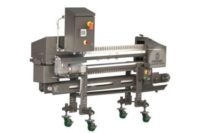Smoke ‘Em if You Got ‘Em
By Sam Gazdziak, Senior Editor
The smokehouse is becoming an increasingly valuable part of any further-processing operation.
Smokehouses are much more than a stainless-steel box that heats up its contents. Food safety, shelf life, food appearance and taste all can be improved by including a smokehouse as part of the production process.
At its most basic, a smokehouse is a convection oven that passes hot air over the products inside. The specifics of a particular smokehouse — the size, heat source, type of smoke, number of fans, batch or continuous — will depend on the types of meat products that will be cooked inside it.
Air flow in an oven can be as simple as a single fan that blows air equally down the sides of the oven to oscillating air movement where high-velocity air moves down the walls and across the floor to meet the low-velocity air that moves down the wall, explains Steven Lary, national sales manager for Livonia, Mich.-based AmTrade Systems, a distributor of Schröter Technologie GmbH equipment. “The high-velocity air then changes to the other side and allows the air to move back and forth across the product. This air movement provides better uniformity in the cooked product,” he says. A two-fan design, where each fan is controlled by a frequency drive, can further fine-tune the air flow for speed and time.
The individual components of a standard smokehouse have changed and improved over the years. Control systems, for instance, have shifted from analog to microprocessors. Seth Pulsfus, R&D technical service manager for Alkar-RapidPak in Lodi, Wis., notes the recent development of Windows-based control systems. He says that addition allows managers to view the smokehouse data remotely and download the data for future reference. “Making sure you have total quality control over that oven is important in this day and age,” he points out. “A lot of managers are taking responsibility of the remote-viewing software, and while they’re in their offices, they can take a look at the ovens and make sure they’re operating correctly.”
Marty Wimmer, thermal processing product manager for Overland Park, Kan.-based Marlen Research Corp., says that chain-driven dampers, which had been an industry standard, have been dramatically improved. “Rotating dampers are direct coupled via a common shaft to ensure that the rotating dampers cannot get out of phase,” he says. A further advancement is a patent-pending damper brake that keeps the dampers in perfect alignment.
Cooking up versatility
The types of food products that can be run through a smokehouse continue to grow. Laurie Friedrich-Bargebuhr, president at Friedrich Metal Products of Greensboro, N.C., says that she is seeing companies use smokehouses for an increasing variety of items. “One example is a foodservice customer that replaced some of its traditional baking ovens with our ovens, and now uses them for everything from quiche and pot pies to roast beef and turkey breast,” she says.
The traditional items cooked in smokehouses have included hams, bacon, sausages, slicing logs and deli items. However, seafood, cheese and other specialty items can also be smoked or cooked in a smokehouse. Some processors have even been using their smokehouses as a thermal kill-step on other equipment, Wimmer says. “They will actually place another piece of equipment in the oven and run a high-steam temperature steam step to kill any potential bacteria,” he notes.
The manner in which those meat products are cooked have changed as well. Tim Moskal, thermal processing manager for Reiser, distributor of Vemag smokehouses based in Canton, Mass., points out that hot dogs were cooked to temperatures of about 150 degrees twenty years ago. Today, hot dogs are commonly cooked to 170 degrees. Benefits include increased food safety and shelf life, but he says, “that puts a little more demand, a little more load on the system and makes the units work a little harder to achieve those temperatures.”
Moskal says that he has seen more companies using high-temperature smokehouses that can operate at temperatures above 275 or 300 degrees. “Because of the desire to develop newer product profiles, tastes and characteristics, customers are now using smokehouses to do what you would call roasting or baking,” he explains. “That imparts a much different flavor profile to the product.” Those units would have to be specially designed, Moskal adds.
One smokehouse can be used to cook a number of different foods, but if a processor is concentrating on a certain type of meat product, then the equipment can be designed to meet specified needs. “Snack sticks require more air changes than hams due to the increased surface area of the product that must be dried. A smokehouse can be designed with higher airflows to accommodate that kind of product,” Lary says. “Turkey products and uncured products require either electric or steam heat to avoid the discoloration of the product from the nitric oxide in the combustion gases of a gas burner.”
Moskal says that in a traditional dry process, processors dry the surface of the product so that is will accept a smoke or develop a certain color characteristic. Many operators are now using the smokehouse for a cook-in-the-bag process. “We don’t care about any kind of a surface condition being set up on it, because the product is being cooked in a bag. All we want to go is get the product cooked.” He said that turkey breasts, hams or roast beef are items that could be cooked with this method.
Alkar-RapidPak’s Pulsfus agrees that a high-humidity steam cook is a very uniform way to cook the product. “It’s [also] a very efficient way of driving heat into the product,” he says.
The right fit
A good smokehouse may last in a processing plant for several decades, so finding one that is a good fit for the company is important. Pulsfus stresses the importance of finding a unit that incorporates sanitary design principles. “[Make] sure the ovens are designed so that you can clean them,” he says, noting the importance of design features such as pitched roofs and cleanable ductwork design. “It’s very important from a food-safety standpoint that the ovens are being cleaned, and [employees] can get inside the oven and inspect.”
When it comes to the specifics, Moskal notes that there are several ways to direct the airflow in the smokehouse. “Some of the differences are in the design of the ductwork and how uniformly it supplies the air and returns the air from the processing chamber. What you want is the system that will supply and return air to the chamber as uniformly as possible.” He also recommends a fan or blower design with the highest possible static efficiency, which he likens to miles per gallon in a car.
Depending on the application, Lary recommends looking at equipment that will complement the smokehouse to further improve the process. A dedicated blast chiller, either a stand-alone model or a connected system, is use extensively with European smokehouses. In either case, product is moved directly from the smokehouse to the chiller. “No one touches the product, thus reducing the potential for product contamination,” he says. “Not only is the product chilled faster, but the weight loss is reduced over a conventional holding cooler.”
Naturally, proper service and support should also be considered. “Your smokehouse will last a long time, so the relationship you have with the company you purchase it from is important,” adds Friedrich-Bargebuhr. “Make sure the manufacturer has a good, stable history, and that support, whether in the form of service or parts, is readily available. In addition, try to think about how you may want to use the equipment in the future and whether your needs will be met.”
Liquid vs. natural
There are two ways to generate the smoke flavor that a smokehouse can impart on a product. Processors can either burn wood and let the natural smoke pass over the meat products, or they can drench the products in liquid smoke. There are advantages and disadvantages to either process. The choice will ultimately lie with the processor and what its customers want.
Friedrich-Bargebuhr notes that many companies switched from natural to liquid smoke in the 1980s when air emissions started to affect processing companies. “The easiest way to keep on the good side of the Environmental Protection Agency was to convert,” she explains, adding that the tide has started to turn back to natural smoke. “With more consumers searching out ‘natural’ foods, companies that want to capture that market are looking to include the ‘naturally smoked’ label on their products.”
An additional reason to return to natural smoke is that technology now exists that addresses emissions in a more economical way than traditional afterburners did 20 years ago. “We have actually had some customers, who went from natural to liquid smoke, convert at least some of their operation back to natural smoke specifically to market ‘naturally smoked’ products,” she says.
Pulsfus says, “From an efficiency standpoint, liquid smoke is sometimes a little easier to work with, a little faster processing. It’s really what [processors] are trying to target for a finished-product flavor. The nice thing with using liquid smoke is if you want to make it a little bit darker, you can use a heavier concentration of liquid smoke. If you’re going to make a darker ham [with natural smoke], there’s a little bit more fine-tuning on the oven settings and parameters.”
Moskal says that the ultimate decision in using liquid versus natural smoke lies with the customers, and what sort of product they profiles they are expecting. “There are several major processors of bacon in the U.S., and they simply would not do it any other way than use natural smoke. They just can’t develop the characteristics [with liquid smoke],” he says. “The same can be true of hot dogs and liquid smoke. If you have a certain customer base and a certain clientele and specification that will require you to use one or the other, that’s what you do.”



Report Abusive Comment